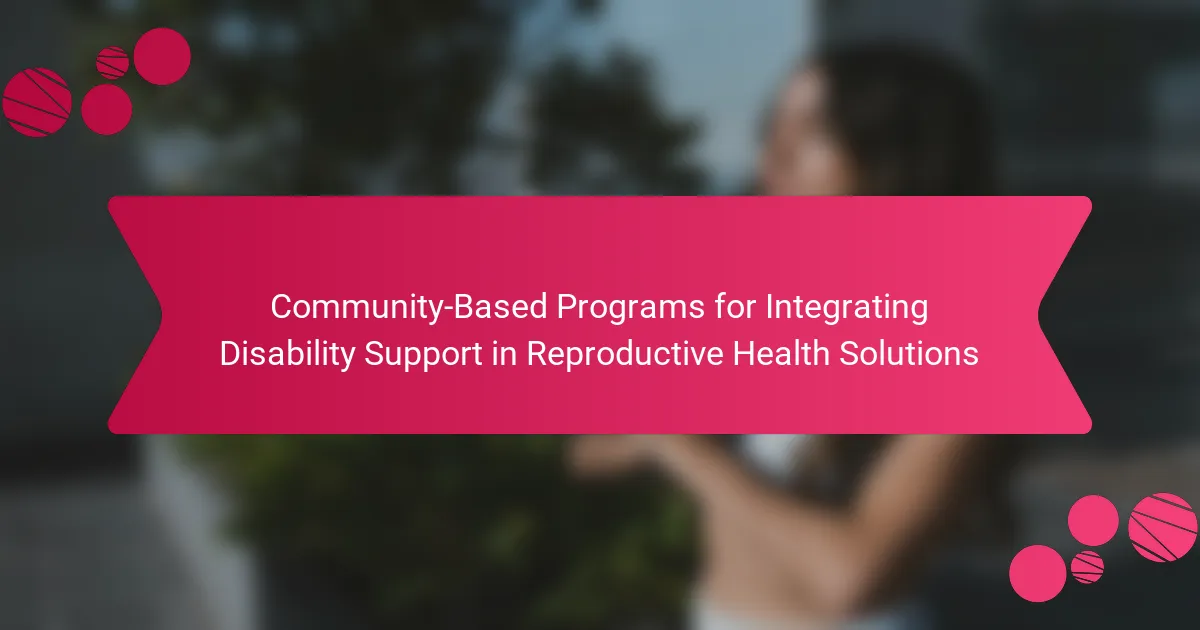Community-based programs for integrating disability support in reproductive health solutions enhance accessibility and education for individuals with disabilities. These programs face challenges like limited funding and inadequate staff training. Effective collaboration with local organizations and advocacy groups is essential. Utilizing technology improves outreach and resource sharing, leading to better health outcomes through tailored support and community engagement.
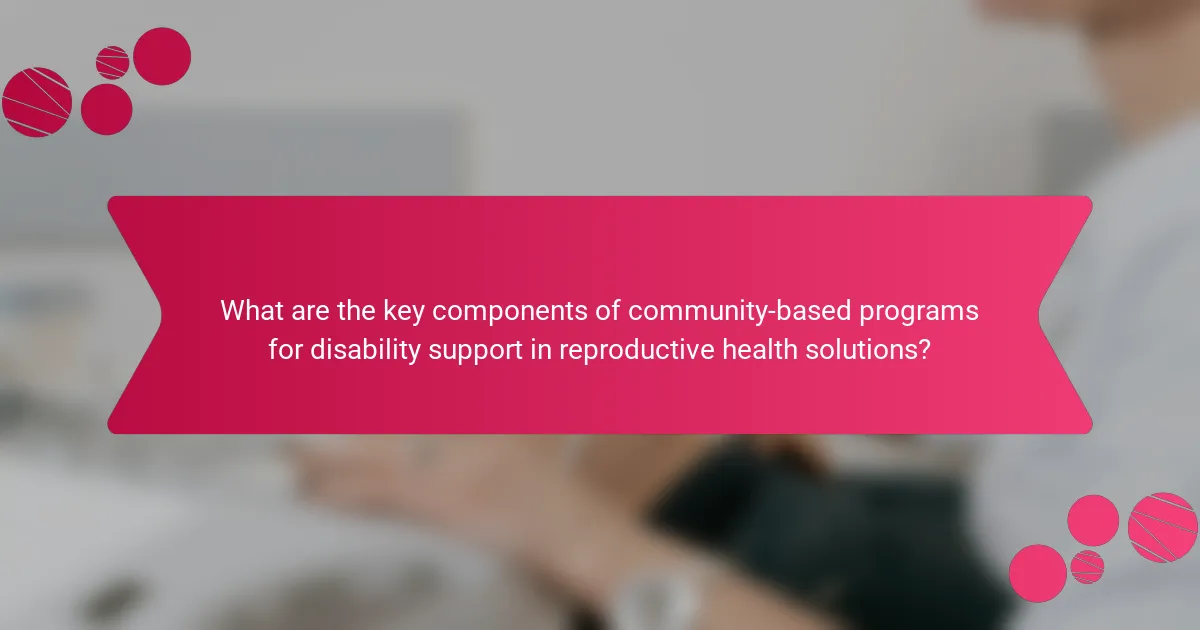
What are the key components of community-based programs for disability support in reproductive health solutions?
Community-based programs for disability support in reproductive health solutions focus on accessibility, education, and advocacy. Key components include tailored services, trained staff, community engagement, and partnerships with local organizations. These elements ensure that individuals with disabilities receive comprehensive reproductive health care that meets their unique needs. Effective communication strategies and inclusive practices are essential for fostering trust and participation within the community.
How do these programs address the specific needs of individuals with disabilities?
Community-based programs effectively address the needs of individuals with disabilities by offering tailored reproductive health solutions. These programs prioritize accessibility, ensuring that services are physically reachable and culturally sensitive. They incorporate education and awareness initiatives that empower individuals with disabilities to make informed choices about their reproductive health. Additionally, these programs foster collaboration with healthcare providers to create inclusive environments that respect the unique needs of each individual. By integrating support mechanisms, they enhance overall health outcomes and promote autonomy among participants.
Which stakeholders are involved in the implementation of these programs?
Key stakeholders in implementing community-based programs for integrating disability support in reproductive health include local health authorities, non-governmental organizations, community leaders, healthcare providers, disability advocacy groups, and affected individuals. Each stakeholder plays a crucial role in ensuring the programs are effective and inclusive. Collaborative efforts enhance resource sharing, promote awareness, and improve access to reproductive health services for individuals with disabilities.
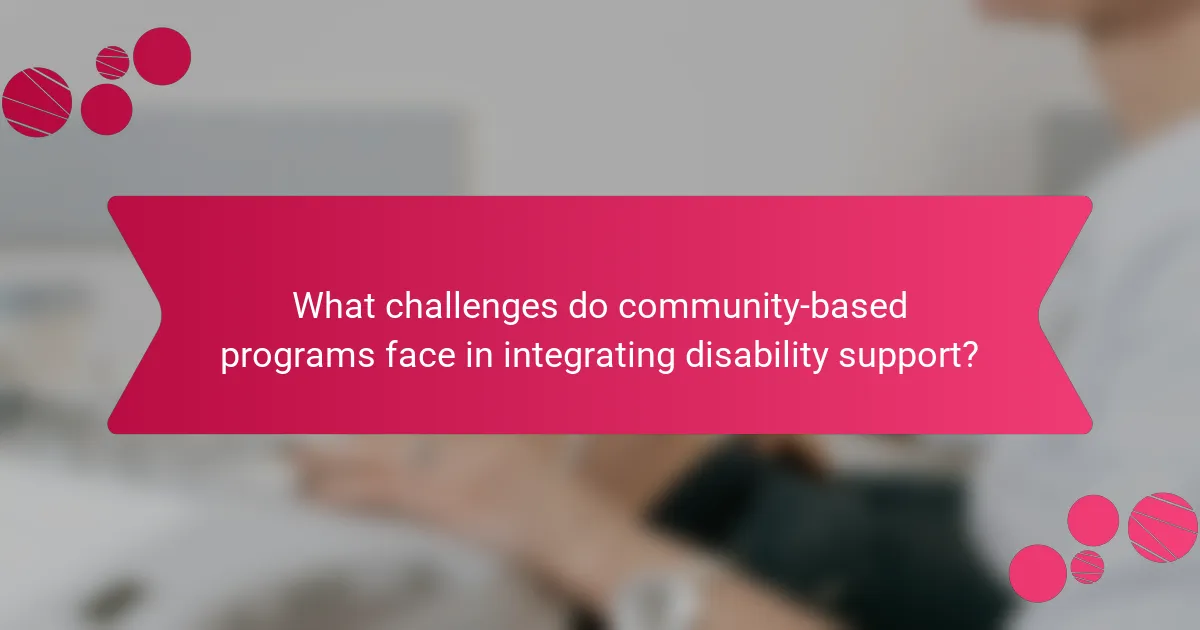
What challenges do community-based programs face in integrating disability support?
Community-based programs face significant challenges in integrating disability support in reproductive health solutions. Key issues include limited funding, inadequate training for staff, and insufficient community awareness.
Funding constraints often hinder program development and sustainability. Staff may lack the necessary training to effectively support individuals with disabilities, leading to gaps in service delivery. Furthermore, community awareness about the specific needs of disabled individuals in reproductive health is often low, resulting in stigma and isolation.
Effective collaboration with disability advocacy groups can enhance program outreach and resource sharing. Programs must prioritize inclusive training and education to address these barriers and improve overall support.
How do cultural perceptions influence the effectiveness of these programs?
Cultural perceptions significantly impact the effectiveness of community-based programs for integrating disability support in reproductive health solutions. These perceptions shape attitudes towards disability, influence participation rates, and determine the acceptance of services offered.
Programs that align with cultural values and beliefs tend to see higher engagement levels. For instance, communities that prioritize family involvement in health decisions may benefit from programs that incorporate family education and support. Conversely, programs that clash with local customs may struggle to gain traction, leading to underutilization.
Understanding cultural nuances allows for tailored messaging and outreach strategies. This customization enhances trust and fosters collaboration between service providers and community members. As a result, culturally sensitive approaches can improve health outcomes for individuals with disabilities by ensuring that programs resonate with community values and norms.
What are the common barriers to access for individuals with disabilities?
Common barriers to access for individuals with disabilities include physical, informational, and financial obstacles. Physical barriers involve inadequate facilities and transportation options. Informational barriers arise from a lack of accessible resources and communication methods. Financial barriers often stem from high costs associated with healthcare services. Addressing these barriers is crucial for effective integration of disability support in reproductive health solutions.
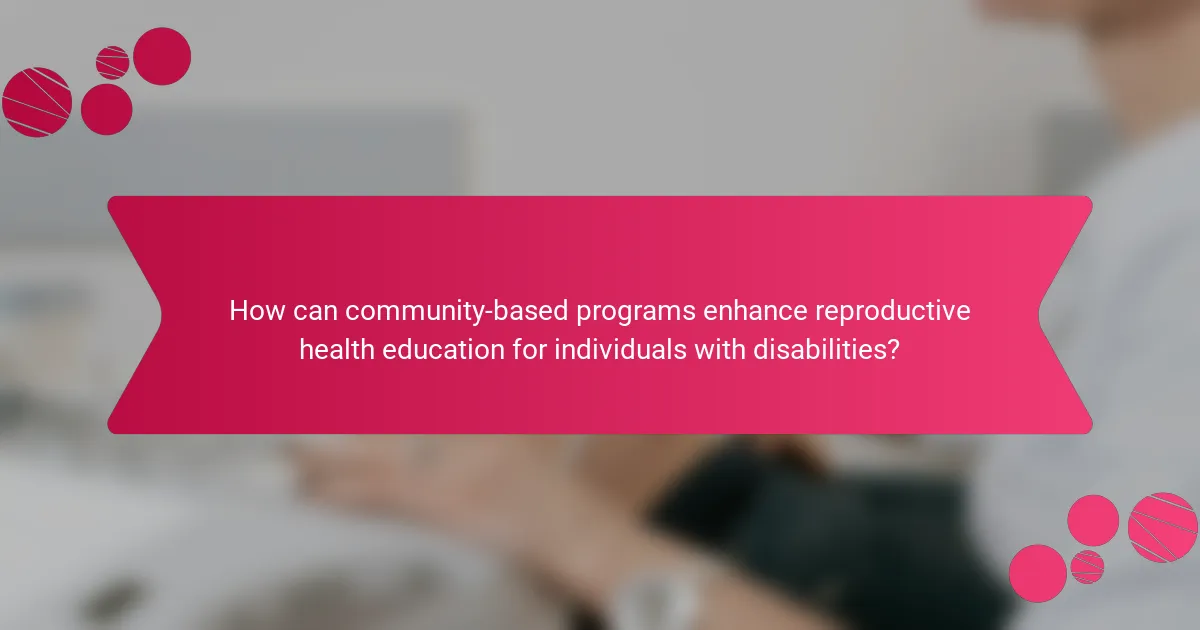
How can community-based programs enhance reproductive health education for individuals with disabilities?
Community-based programs significantly enhance reproductive health education for individuals with disabilities by providing tailored resources and support. These programs foster inclusive environments that address unique needs, ensuring accessible information and services. They empower individuals through workshops, peer support, and advocacy, creating a stronger community connection. As a result, participants gain confidence and knowledge, leading to improved health outcomes.
What methods are effective in delivering reproductive health education to diverse audiences?
Community-based programs effectively deliver reproductive health education to diverse audiences by incorporating tailored approaches. These programs engage local leaders to foster trust and culturally relevant content. Utilizing peer educators enhances relatability and accessibility, ensuring messages resonate. Additionally, integrating disability support addresses unique needs, promoting inclusivity. Collaborative efforts with healthcare providers increase resource availability and awareness, creating comprehensive educational networks.
Which resources are essential for training facilitators in these programs?
Essential resources for training facilitators in community-based programs include comprehensive training manuals, access to expert-led workshops, online course materials, and collaborative networks for ongoing support. These resources enhance facilitators’ understanding of integrating disability support in reproductive health solutions.
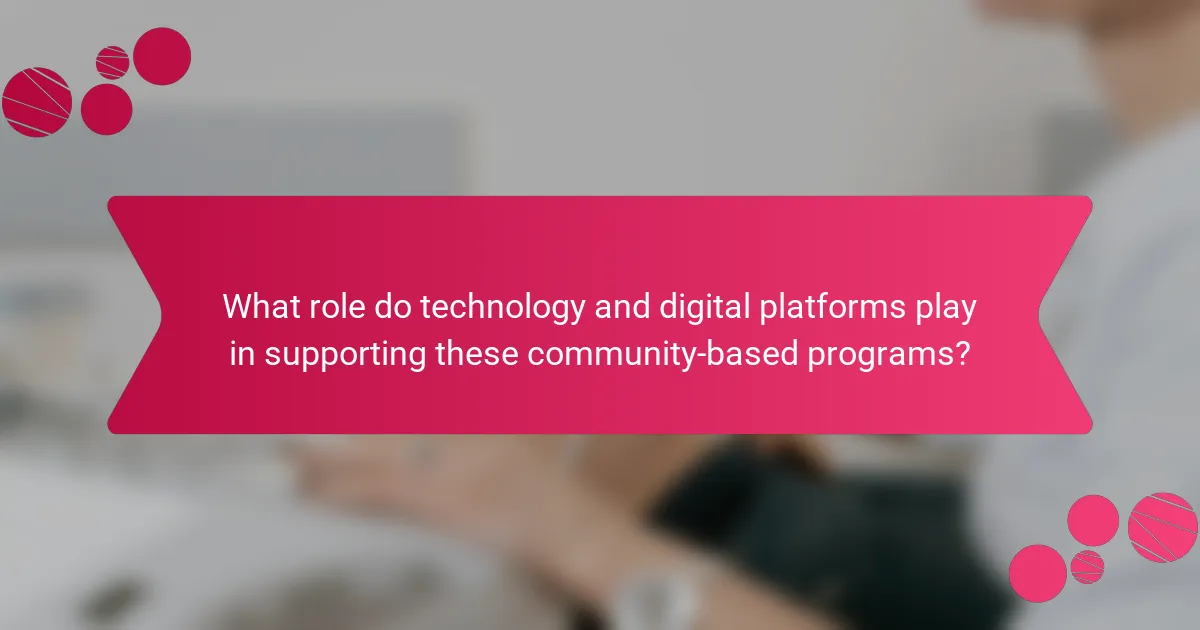
What role do technology and digital platforms play in supporting these community-based programs?
Technology and digital platforms significantly enhance community-based programs for integrating disability support in reproductive health solutions. They improve accessibility, facilitate communication, and provide vital resources. Digital tools enable remote consultations, ensuring individuals with disabilities receive necessary support without barriers. Moreover, data analytics can identify community needs, tailoring programs effectively. Social media platforms foster community engagement, raising awareness and promoting inclusivity.
How can telehealth services improve access to reproductive health resources?
Telehealth services enhance access to reproductive health resources by removing geographical barriers and providing tailored support. They facilitate connections to community-based programs, ensuring individuals with disabilities receive necessary reproductive health services. This integration improves overall health outcomes and promotes inclusivity. Additionally, telehealth can offer real-time consultations, educational resources, and personalized care plans, making reproductive health more accessible for all.
What are the benefits of using mobile applications for education and support?
Mobile applications enhance education and support by providing accessible resources, fostering community engagement, and facilitating communication. They offer tailored learning experiences, enabling users to access information at their convenience. These applications can also integrate features that support individuals with disabilities, ensuring inclusivity in reproductive health solutions. As a result, users benefit from improved knowledge, empowerment, and connection to support networks.
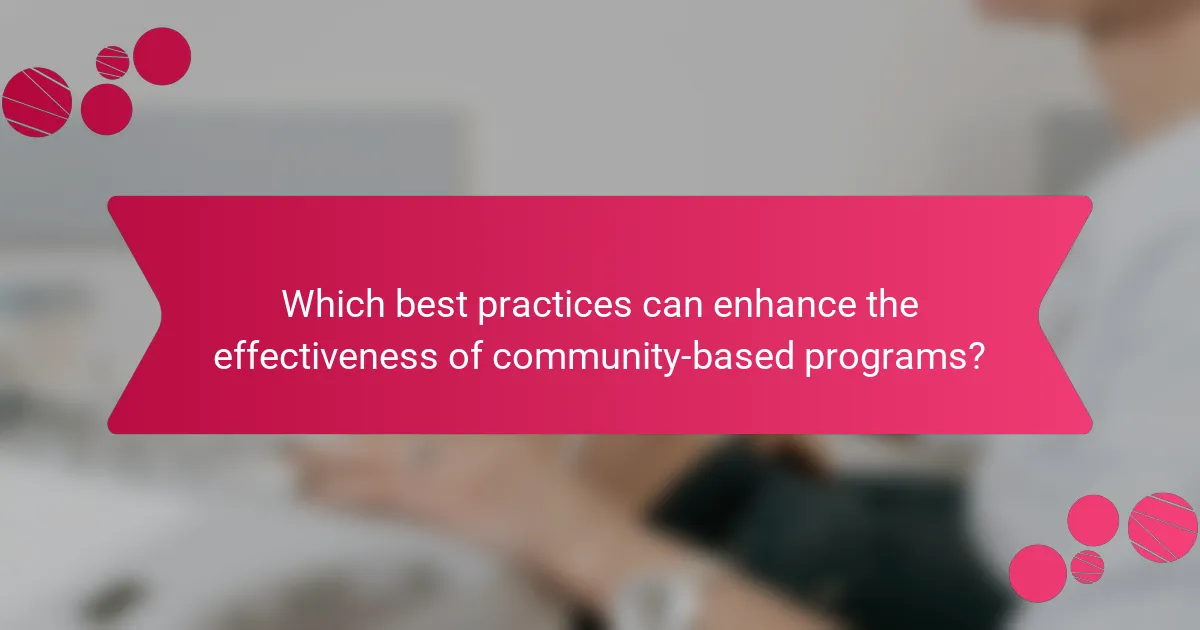
Which best practices can enhance the effectiveness of community-based programs?
Engaging stakeholders and fostering collaboration enhance the effectiveness of community-based programs. Building partnerships with local organizations ensures diverse perspectives and resources. Training staff on disability awareness promotes inclusivity in reproductive health solutions. Regular feedback from participants helps refine program strategies. Implementing culturally sensitive approaches increases community trust and participation.
What strategies foster collaboration among local health providers and organizations?
Collaboration among local health providers and organizations can be fostered through community-based programs focused on integrating disability support in reproductive health solutions. These strategies include establishing partnerships, sharing resources, and creating inclusive policies.
1. Build partnerships with local organizations to enhance service delivery.
2. Conduct joint training sessions for health providers on disability awareness.
3. Implement shared data systems for better coordination of services.
4. Develop inclusive outreach programs to engage diverse communities.
5. Evaluate and adapt programs based on community feedback to ensure effectiveness.
How can feedback from participants be utilized to improve program outcomes?
Feedback from participants can significantly enhance program outcomes by identifying areas for improvement. Engaging participants in discussions allows program coordinators to understand their experiences and challenges. This feedback can inform adjustments in service delivery, ensuring that programs are tailored to meet the specific needs of individuals with disabilities in reproductive health contexts. Regularly collecting and analyzing participant feedback fosters a culture of responsiveness and continuous improvement, ultimately leading to better health outcomes and participant satisfaction.
What common mistakes should be avoided when implementing these programs?
Common mistakes to avoid include inadequate stakeholder engagement, lack of tailored resources, and insufficient training for staff. These oversights can hinder the effectiveness of community-based programs in integrating disability support within reproductive health solutions. Additionally, failing to consider diverse needs may limit accessibility and participation. Regular evaluations and feedback mechanisms are essential to adapt and improve programs continuously.
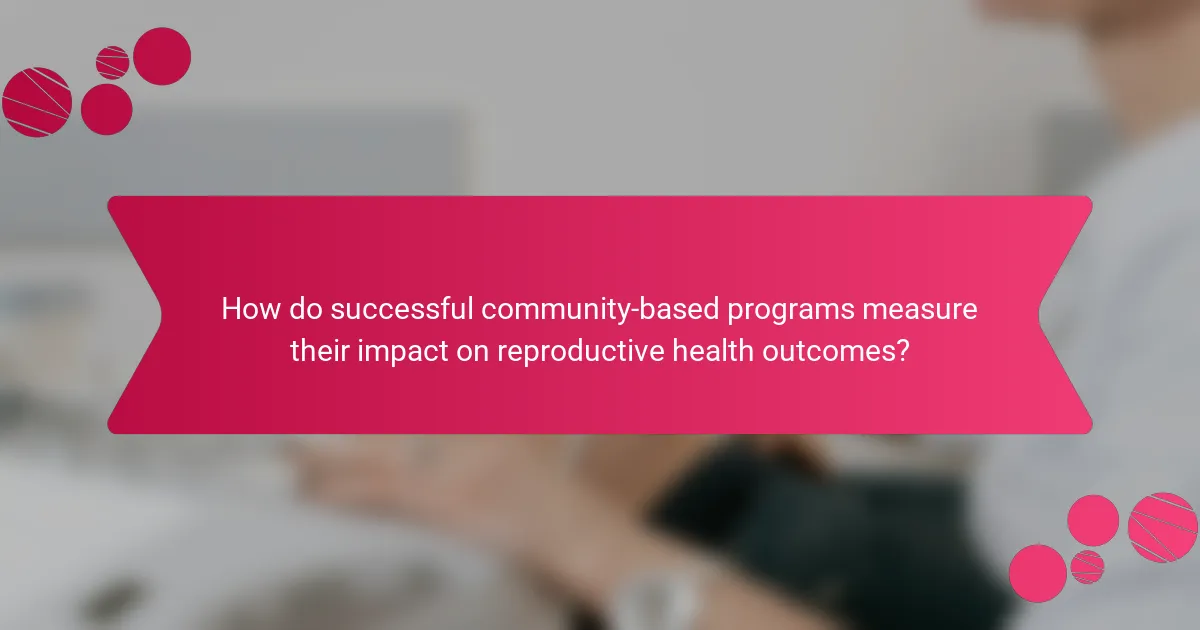
How do successful community-based programs measure their impact on reproductive health outcomes?
Successful community-based programs measure their impact on reproductive health outcomes through targeted data collection and analysis. They utilize pre- and post-intervention surveys to assess changes in knowledge, attitudes, and behaviors related to reproductive health.
Programs often track specific metrics such as the rate of contraceptive use, access to services, and changes in health outcomes like maternal mortality rates. Engaging community members in the evaluation process enhances the relevance and accuracy of the data collected.
Additionally, qualitative methods, such as focus groups and interviews, provide deeper insights into community needs and the effectiveness of interventions. This combination of quantitative and qualitative data allows for a comprehensive understanding of program impact.
Finally, successful programs continuously adapt based on feedback and findings, ensuring they remain responsive to community needs and improve reproductive health outcomes effectively.
What metrics are used to evaluate the effectiveness of disability support initiatives?
Metrics used to evaluate the effectiveness of disability support initiatives include user satisfaction, accessibility improvements, participation rates, and health outcomes. These metrics help assess how well community-based programs integrate disability support in reproductive health solutions.
| Metric | Description | Value Example |
|—————————-|—————————————————–|———————-|
| User Satisfaction | Measures participant feedback on services provided | 85% satisfaction rate |
| Accessibility Improvements | Assesses changes in physical and digital access | 30% increase in access|
| Participation Rates | Tracks engagement levels in programs | 40% increase in enrollment|
| Health Outcomes | Evaluates improvements in health metrics | 25% reduction in complications|
How can data collection methods be improved for better insights?
Data collection methods can be improved by incorporating community engagement and feedback. Actively involving individuals with disabilities in the design and implementation of programs enhances data relevance and accuracy. Utilizing mixed methods, such as surveys and focus groups, can provide a comprehensive understanding of reproductive health needs. Additionally, leveraging technology for real-time data collection can streamline insights and ensure timely responses to emerging issues. Regular training for data collectors on sensitivity and inclusivity can further enhance data quality and trust among participants.
What role do participant testimonials play in assessing program success?
Participant testimonials are crucial for assessing the success of community-based programs in integrating disability support into reproductive health solutions. They provide firsthand insights into participant experiences, revealing program effectiveness and areas for improvement. Testimonials often highlight personal transformations, illustrating unique attributes of the program. Quantitative data from surveys can complement these narratives, offering a comprehensive view of participant satisfaction and program impact. This combination of qualitative and quantitative feedback fosters continuous improvement and ensures programs meet the needs of diverse communities.
What practical tips can organizations follow to optimize community-based programs for integrating disability support?
Organizations can optimize community-based programs for integrating disability support in reproductive health by implementing inclusive practices. Focus on training staff to understand diverse needs, ensuring accessibility in facilities, and fostering partnerships with disability advocacy groups. Regular feedback from community members enhances program relevance and effectiveness. Utilize technology to streamline access to resources and information, ensuring that all materials are available in multiple formats.
